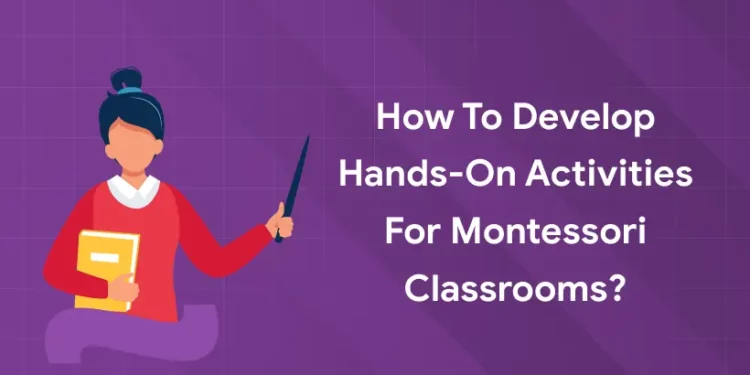Table of Contents
“The hands are the instruments of man’s intelligence.” These are the words of world-famous educator Dr Maria Montessori. Montessori classrooms are well known for their distinctive teaching methods, which emphasize experiential learning to promote development and self-reliance. This approach, in contrast to conventional models, uses top-notch educational resources that encourage inquiry and discovery while enabling kids to interact directly with their surroundings. So let us learn How to Develop Hands-On Activities for Montessori Classrooms and why they are important.
Get the best mentors to learn Montessori philosophy! Click here to Register for the course!
How to Develop Hands-On Activities for Montessori Classrooms: Introduction
Imagine a classroom where kids are actively exploring their surroundings rather than being cooped up at desks. Instead of just passively taking in information, they are actively participating in hands-on activities, conducting experiments, and working with materials. This is not an idealistic view; rather, it is the foundation of Montessori education, which holds that experiential learning develops a child’s full potential and fosters a lifelong love of learning.
The way that Montessori encourages children to learn by touching, feeling, and doing is one of the ways that it differs from more traditional educational methods. Children sit at desks and listen to teachers in traditional learning settings. Montessori kids, on the other hand, are encouraged to wander freely around the classroom and participate in the many different activities that are offered. They select the task they want to do, carry it over to a table or mat, explore the materials, and come to their conclusions.
Learn the Montessori method from experts! Join the Entri Elevate Montessori course today!
How to Develop Hands-On Activities for Montessori Classrooms?
1: What is the primary focus of the first plane of development in the Montessori method?
A child’s educational journey is greatly aided by hands-on learning since it enables them to actively interact with the subject matter and pursue their interests. This method emphasizes giving kids the freedom to learn at their speed while incorporating a range of practical exercises to support their growth. But the question is “How to Develop Hands-On Activities for Montessori Classrooms?”. Certain elements are the foundations of the hands-on activities that are done in a Montessori classroom. What you must do is understand these basics and create activities with these themes as the foundations. Let us look at the themes that form the foundation of the hands-on learning activities in the Montessori method.
Practical Life Skills
Montessori places a strong emphasis on the value of acquiring useful life skills at a young age. These exercises promote self-reliance, focus, and coordination. Sorting items by size and colour, tying shoelaces, and pouring water from one container to another are a few examples. Children gain hand-eye coordination, fine motor skills, and a sense of accomplishment by participating in such activities. So, you must keep in mind to include life skill building in mind while creating an activity for a Montessori classroom. Some such activities are discussed below.
Activities Using Maps and Practical Geography
Encourage the creation and reading of maps to foster spatial awareness and useful life skills. This exercise blends critical thinking, art, and geography. Here are some ideas for activities.
- Make a map of the school or classroom.
- Utilize a basic map to find your way around an outdoor area.
- Create treasure hunts with basic map-reading abilities.
Challenges of Collaborative Problem-Solving
Create tasks that call for cooperation and innovative problem-solving techniques. This encourages communication, teamwork, and social skills. Class challenge ideas can be found below.
- Using limited resources to construct the tallest tower
- Building a functional pulley system
- Creating a solution for a local environmental problem
Station for Practical Life Skills
Establish a station where students can practice daily skills, encouraging self-reliance and self-assurance. Fine motor skills, focus, and a sense of responsibility are all enhanced by this activity. Activities to incorporate are:
- Liquids being poured between containers
- Practice boards for zipping, tying, and buttoning
- Basic food preparation duties, such as putting butter on bread or making cookies
- Scooping food
- Washing window
- Gluing paper
To make sure your students are appropriately challenged, you can modify the instruction based on their age.
Sensorial Exploration
Giving kids the chance to explore their senses is another crucial component of the Montessori method. Identifying distinct smells, matching fabrics based on texture, and listening to various sounds are just a few of the activities that aim to stimulate the senses. Children’s observational abilities, sensory integration, and classification and differentiation skills are all improved by these experiences. So, create hands-on activities that stimulate the senses. A few activities coming under this theme are listed below.
Tactile Exploration Sensory Bins
A great way to stimulate students’ senses and encourage tactile learning is with sensory bins. Curiosity, fine motor skills, and sensory awareness are all improved by this activity. Some things to keep in mind while creating this activity are listed below.
- Give the bins distinct themes, such as space, forest, or ocean.
- Add instruments such as tweezers, scoops, or magnifying glasses.
- Students should be encouraged to explain the colours, textures, and shapes they come across.
- You can differentiate this exercise by asking students to point out specific elements in the bin or, if you want to go further, by asking them to find and explain a theme for the bin or bins.
Observation and Nature Walk
Take a nature walk with a guide to learn about the outdoors and develop observational skills. Curiosity, environmental consciousness, and scientific thinking are all encouraged by this activity. Things to keep in mind during this activity are:
- Provide collection containers and magnifying glasses.
- Students should be encouraged to illustrate or explain their findings.
- Talk about how ecosystems and nature are interconnected.
An Art Station Inspired by Montessori
Create an art space with a variety of supplies to encourage unrestricted creativity. This promotes the development of fine motor skills, aesthetic appreciation, and self-expression. Items to be included are given below.
- Watercolors and various paper types
- Playdough or clay for modelling
- Natural collage-making materials, such as twigs and leaves
Math Manipulatives
In Montessori classrooms, the use of hands-on materials makes mathematical concepts tangible. Youngsters can learn the fundamentals of number recognition, counting, and basic operations by using tools like number rods, sandpaper numerals, or the well-known golden beads. Working with these manipulatives helps kids tangibly understand abstract ideas, laying the groundwork for future mathematical comprehension. Therefore, always try to include mathematical instruction during hands-on activities. For example, you can ask a student to count objects during the “identify the object” activity. A few activities that are on par with this theme are given below.
Creating Your Own Montessori Materials
To introduce mathematical concepts, make simplified versions of the traditional Montessori materials. This practical method aids students in visualizing abstract concepts and builds a solid mathematical foundation. Examples of these kinds of activities include:
- Use coloured popsicle sticks to represent number rods.
- Bead bars to help with basic operations and counting
- DIY geometric solids with playdough or clay
Measuring Things
Non-standard units of measurement are frequently introduced in Montessori classrooms during the early phases of measurement education. Youngsters measure the length, width, and height of various objects using tools like straws, paper clips, and blocks. This exercise presents the idea of units of measurement and aids in the development of their spatial awareness.
As they grow, kids are exposed to common measurement units like meters, centimetres, grams, and kilograms. Children can practice measuring various objects using these units by using the rulers, scales, and measuring tapes that are provided in Montessori classrooms. Children learn about measurement accuracy and precision through this activity. Measuring weight, measuring volume with water and containers and measuring temperature comes under this theme.
Activities for Estimation
In the Montessori classroom, estimation exercises are an important component of measurement lessons. Before actually measuring various objects, children are asked to estimate their length, weight, or capacity. Their critical thinking, reasoning, and ability to make educated guesses based on past knowledge are all enhanced by this activity.
Time Measurement Activities
Time measurement is a crucial skill, and Montessori classrooms frequently offer a variety of exercises to help kids learn and practice it. Kids are encouraged to use timers or clocks to measure particular intervals as they learn about the various time units, such as seconds, minutes, or hours. Through this exercise, they improve their time management abilities in addition to their comprehension of time.
Development of Language
Language development is also covered in Montessori activities. Youngsters participate in a variety of language activities, including sound games, movable alphabets, and sandpaper letters. These exercises aid in vocabulary development, phonemic awareness, and letter recognition. Children learn to form words, associate letters with sounds, and improve their reading and writing abilities through interactive language resources. Therefore, some hands-on activities should be designed in a way that aids language learning. Some related activities are discussed below.
Letters on Sandpaper for Multisensory Education
Use sandpaper letters to introduce letters and phonics. This tactile method stimulates several senses, which helps with early literacy and letter recognition. Examples of such activities are provided below.
- Show how to trace the letter and pronounce its sound.
- Students should be encouraged to feel the letter shape while closing their eyes.
- Incorporate additional sensory exercises, such as letter writing in the sand.
- You might decide to use more difficult assignments with specialized equipment for older pupils.
You might have also noticed that even though this is a language-learning activity it is using the sensory exploration theme too. That means you can mix and match the themes discussed here in any way you want as long as the activity resulting from such a combination is a fun learning experience.
Classification Cards
Montessori activities known as classification cards assist kids in naming and recognizing items in their surroundings. Three classification cards are usually included with each item: one with the object’s name, one with an image of the object, and one with both the name and the image. Kids compare the picture and name cards to the control card to learn how to match them. Classification cards give kids an autonomous way to explore their surroundings and aid in the early development of reading skills. Animals and vegetables are two examples of classification card categories.
Self-correcting Puzzles
Construct or find puzzles that let students evaluate their work. This encourages self-evaluation, independence, and problem-solving abilities. Some ideas for puzzles are provided below.
- Word-picture matching to broaden vocabulary
- Shape sorting exercises to improve your geometry skills
- Puzzles involving number sequences that require mathematical reasoning
This activity is using both language learning and mathematical skill development themes.
Cultural Studies
Cultural studies are embraced by the Montessori method to expand children’s worldviews. Children’s curiosity is piqued and they are exposed to diverse cultures and customs through hands-on activities such as puzzle maps, national flags, or materials for classifying animals. These encounters promote open-mindedness, respect for diversity, and global awareness. The hands-on activities can include dressing up in cultural costumes, learning folk songs and easy cultural dances, conducting storytelling sessions that include culture-related stories etc. Some such activities are listed below.
Mini-research Projects
Give students the freedom to select and investigate subjects that interest them to promote self-directed learning. Independence, critical thinking, and presentation abilities are all enhanced by this. Execution The following are the steps for this activity.
- List age-appropriate subjects or give them free reign.
- Instruct students in identifying trustworthy sources and conducting basic research.
- Promote creative presentations (dioramas, posters, or brief speeches).
Now that you know all the things that are meant to be taught using hands-on activities, try to create activities in such a way as to teach them to kids.
Clear all the Montessori education-related doubts in a doubt clearance session with an expert!
Get Certified & Start Your Montessori Career
Montessori Teacher Training Course by Entri App: Gain expert skills, earn certification, and kickstart your teaching career.
Join Now!Why Hands-On Activities Are Essential in Montessori Education?
You might now be thinking why hands-on activities are essential in Montessori education. Here are some reasons:
Developing the Ability to Think Critically
The open-ended nature of Montessori materials permits a variety of interpretations and methods. Children are actively creating knowledge as they work with these materials rather than merely memorizing facts. A child using the Pink Tower, a set of ten cubes of increasing size, is not only stacking blocks; they are also learning to compare sizes, sequence, and use spatial reasoning. They gain the ability to recognize patterns and resolve issues on their own by making mistakes. This encourages critical thinking, which is an essential ability for surviving in a world that is getting more complicated by the day.
Developing Problem-Solving Skills
Children can experiment and make mistakes in a safe environment when they are engaged in hands-on activities. Consider a kid filling a container with water from a pitcher. They might spill if they overfill. This could be viewed as a bad thing in a conventional classroom. But it’s a worthwhile educational experience in a Montessori classroom. The child modifies their strategy, improves their pouring technique, and observes the cause-and-effect relationship. The problem-solving abilities developed through this iterative process of trial and error extend well beyond the confines of the classroom.
Developing a Passion for Learning
Montessori education aims to create stimulating and interesting learning environments. Pupils are given the freedom to select the activities that interest them, which helps them feel in control of their education. They develop a sense of achievement and a love of learning as they investigate and discover things on their own. This internal drive paves the way for lifelong learning, in which acquiring knowledge is no longer a duty but a personal quest.
Creating a Solid Foundation for Future Learning
A Montessori classroom’s practical experiences provide a solid basis for future academic achievement. Children gain a deeper comprehension of abstract ideas through the manipulation of tangible materials. Children can better understand addition and subtraction before they even come into contact with formal mathematical symbols by using the Number Rods, a set of wooden rods of various lengths. In later years, they can more easily and confidently expand on their knowledge due to this solid foundation.
Including Sensorimotor Learning
Sensorimotor learning, which uses the senses to gather information, is emphasized in Montessori classrooms. This multisensory approach guarantees a more comprehensive understanding while accommodating various learning styles. For instance, learning the alphabet with sandpaper letters involves both touch and sight, which helps a broader range of learners retain and understand the alphabet.
Developing Curiosity and Confidence
Children gain confidence in their skills by investigating real-world ideas through practical exercises. Curiosity and a lifelong love of learning are fostered by the Montessori method, and this leads to both academic achievement and personal development.
Children’s intellectual potential can be fully realized through hands-on learning, which is more than just a way to keep them entertained. Children in a Montessori classroom actively participate in their learning process rather than being passive consumers of knowledge. Through material manipulation, experimentation, and hands-on activities, they cultivate critical thinking, problem-solving abilities, and a passion for learning that will serve them well in a world that requires flexibility and creative thinking.
In the unique learning environment provided by Montessori schools, experiential learning is prioritized. This method fosters a child’s innate curiosity and a love of learning that transcends the boundaries of the classroom, going beyond rote memorization. A Montessori school might be the ideal choice if you’re searching for an educational environment that will enable your child to develop into a self-assured, self-sufficient, and lifelong learner.
Tips or Best Practices for Ensuring Activities Are Effective
The best way to make sure that the activities are effective is to adhere to the core principles of Montessori education. They are:
- Respect the child’s natural development
- Independence and self-directed learning are emphasized
- Create an atmosphere that encourages exploration
- Mix age groups whenever possible
- Periods of uninterrupted work
As you put these activities into practice, exercise patience and give yourself and your students time to get used to this new method. The advantages of greater autonomy, critical thinking abilities, and engagement will make the work worthwhile. You’re empowering your students to become inquisitive, self-assured, and competent learners by implementing Montessori principles in your classroom.
But where can we learn all these basics of Montessori teaching practises? Have you heard of the Entri Elevate Montessori teacher’s training course? This course is recognised by the American Board of Education, FICS (Forum for International Certified Scholars) and CEED International. The course is of six months duration. It offers many facilities such as expert faculty, live sessions, recorded sessions, PDF notes, live exams via Zoom, doubt clearance sessions and diploma/ PG diploma certification.
Click here to learn more about Entri Elevate Montessori teacher’s training course! Join now!
How to Develop Hands-On Activities for Montessori Classrooms: Conclusion
A fundamental component of the Montessori educational approach is experiential learning. Children can actively participate in their educational journey by using math manipulatives, language development, cultural studies, practical life skills, and sensory exploration. Independence, critical thinking, and curiosity are all fostered by these activities and are essential components of lifelong learning. Increasing experiential learning in conventional classrooms can also be beneficial, igniting students’ interest and involvement. As a result, teachers may find the Montessori method inspiring to include more practical exercises in their lesson plans. All the information provided in this blog should be enough to answer all your thoughts regarding the question “How to Develop Hands-On Activities for Montessori Classrooms?”.
Get Certified & Start Your Montessori Career
Montessori Teacher Training Course by Entri App: Gain expert skills, earn certification, and kickstart your teaching career.
Join Now!Frequently Asked Questions
How can we adapt Montessori methods at home?
When it comes to young children, actions also speak louder than words. Therefore, it is frequently easier to work alongside a toddler than to give them instructions from a distance. It is also more enjoyable to explore the world with them than to explain things to them. It is also pleasant to let your child explore at home. Young infants benefit from rich sensory experiences and tactile and exploratory objects, and toddlers and preschoolers enjoy helping you with everyday tasks like sweeping, cleaning, and dishwashing.
How does hands-on learning affect the neural and motor functions of a child?
Children will form many more neural connections when we can show them and allow them to touch and explore. Additionally, the concrete experiences they have had will inevitably lead to more abstract learning in the future. Your motoric memory is also used when you are using your hands to manipulate materials. The learning process is once more enhanced by this.
How to change the hands-on learning activities according to the age of the students?
Children should have access to a variety of materials in the playgroup so they can begin learning by touching and using their hands. The vocabulary baskets in the baby classes, for instance, are brimming with items that the babies use their hands and mouths to explore. Next, you can match the objects to picture cards in the toddler and preschooler classes to start the abstraction process.
Children will first learn about numbers in a Montessori primary school by working with rods, bead chains, sandpaper numbers, and other materials. They will then learn how to perform these sums abstractly on paper as they advance into upper primary. Skills are guided and supported through this process, which progresses from tangible to abstract ideas. Similarly, children learn to read by first touching, feeling, and hearing the letters while using tools like the moveable alphabet and sandpaper letters. They then go on to reading and writing.











